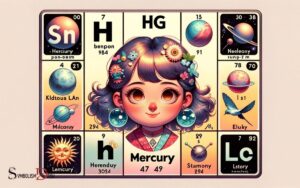Hermes Roman Name and Symbol: Explain!
In Roman mythology, Hermes is known by the name Mercury. His symbol is the caduceus, which features two snakes winding around a winged staff. This emblem is significant in ancient Roman culture and persists today in areas like medicine and commerce.
Mercury, the Roman equivalent of the Greek god Hermes, was revered as the deity of trade, travel, communication, and the messenger of the gods.
The caduceus, Mercury’s distinctive symbol, has been adopted in modern times, often representing medical professions due to its association with healing and negotiation.
Discover the legacy of Mercury, the Roman Hermes, whose caduceus symbol remains influential today.

Key Takeaway
Mercury: Hermes’ Roman Name and Its Enduring Symbol
| Aspect | Details |
|---|---|
| Greek Name | Hermes |
| Roman Name | Mercury |
| Symbol | Caduceus (staff with two intertwined serpents and wings on top) |
| Domain | God of Boundaries, Travel, Communication, Commerce |
| Cultural Impact | Influences modern medicine and commerce symbols |
The Roman Name of Hermes
What is the Roman name for Hermes and how does it differ from his Greek counterpart? In Roman mythology, Hermes is known as Mercury.
While both deities share similar attributes as messengers of the gods, Mercury is also associated with financial gain, commerce, and eloquence.
This reflects the Roman emphasis on trade and communication, aligning with their societal values. The Greek Hermes, on the other hand, is more closely linked to boundaries, transitions, and travelers.
The Roman adaptation of Hermes into Mercury signifies a cultural shift, where the original attributes of the Greek deity were preserved but also evolved to suit the specific needs and beliefs of the Roman people.
The adaptation provides insight into the cultural and societal differences between ancient Greece and Rome.
The Role of Mercury in Roman Mythology
Mercury, known as the messenger god in Roman mythology, played a significant role in the pantheon of Roman deities. Often depicted with winged sandals, Mercury was associated with communication, commerce, and travel.
His presence in Roman mythology was pervasive, and his symbolism continues to hold cultural significance today.
Mercury’s Messenger God
In Roman mythology, Mercury played a crucial role as the messenger god, facilitating communication between the gods and guiding souls to the underworld.
This multifaceted deity held several responsibilities, including:
- Messenger of the Gods: Mercury was the divine messenger who swiftly carried messages between the deities of Mount Olympus.
- Psychopomp: He guided the souls of the deceased to the underworld, ensuring a safe passage for the departed.
- God of Commerce and Travel: Mercury was also associated with commerce, trade, and travel, overseeing the movement of goods and people.
Mercury’s diverse roles reflect the complexity of Roman mythology and the significance of communication, guidance, and commerce in the ancient world.
Symbol: Winged Sandals
Representing Mercury’s swift and agile nature, the symbol of winged sandals embodies his vital role as a messenger and guide in Roman mythology.
The winged sandals, known as talaria, were a divine attribute that enabled Mercury to travel with incredible speed, allowing him to fulfill his duties as the messenger of the gods.
In Roman art and literature, Mercury is often depicted wearing these winged sandals, emphasizing his role as the god of travel, trade, and communication.
The winged sandals not only symbolize Mercury’s extraordinary swiftness but also his ability to transcend boundaries and connect different realms.
This symbol underscores Mercury’s significance in facilitating the flow of information and guiding souls, highlighting his essential role as a mediator between the divine and mortal realms.
Attributes and Spheres of Influence
The attributes and spheres of influence associated with Hermes, the Roman counterpart of the Greek god Hermes, are multifaceted and encompass various domains of human life and experience.
Messenger and Communication:
- Hermes is the divine messenger, facilitating communication between the gods and mortals.
- He governs over language, writing, and oratory skills, guiding individuals in effective communication.
Travel and Commerce:
- Hermes is the patron of travelers, guiding and protecting them on their journeys.
- He presides over trade, commerce, and financial gain, symbolizing the exchange of goods and services.
Trickery and Boundaries:
- Hermes is known for his cleverness and cunning nature, often employing trickery for noble or mischievous purposes.
- He governs boundaries, both physical and metaphorical, and is revered as the protector of travelers and shepherds.
The Caduceus Symbol
Associated with Hermes, the Caduceus symbolizes the abstract concept of balance and harmony, embodying the intertwining of dualities and the reconciliation of opposites. The Caduceus consists of a short staff entwined by two serpents, sometimes surmounted by wings.
Below is a table that provides a breakdown of the key elements of the Caduceus symbol:
| Element | Representation |
|---|---|
| Staff | Symbol of authority |
| Serpents | Representing dualities |
| Wings | Symbolizing swiftness |
| Knot | Signifying unity |
The intertwining serpents are often interpreted as representing the balance between opposing forces such as life and death, good and evil, or the conscious and unconscious mind. The Caduceus symbol thus serves as a timeless emblem of equilibrium and reconciliation.
Caduceus in Ancient Roman Culture
The caduceus, a symbol associated with Hermes in Greek mythology, holds significant symbolism in ancient Roman culture as well. In Roman mythology, the equivalent of Hermes is the god Mercury, and the caduceus is closely linked to him.
Understanding the role and symbolism of the caduceus in ancient Roman culture sheds light on the significance and influence of Hermes’ symbol in the Roman world.
Hermes’ Staff Symbolism
In ancient Roman culture, Hermes’ staff, known as the Caduceus, held significant symbolism and was associated with various aspects of commerce, negotiation, and guidance.
The Caduceus was commonly seen as a symbol of trade, eloquence, and negotiation, reflecting Hermes’ role as the messenger of the gods and the patron of merchants.
Additionally, the staff’s entwined serpents were believed to represent balance, harmony, and duality, signifying the reconciliation of opposites and the resolution of conflicts.
Moreover, the wings attached to the staff symbolized swiftness and agility, underscoring Hermes’ role as a guide and messenger between different realms. Overall, the Caduceus served as a powerful emblem of Hermes’ multifaceted influence in Roman culture.
Roman God Mercury
Mercury, the Roman counterpart of Hermes, wielded the Caduceus with analogous symbolism in ancient Roman culture, embodying similar attributes of commerce, negotiation, and guidance.
In Roman mythology, Mercury was considered the god of financial gain, commerce, eloquence, communication, travelers, boundaries, luck, trickery, and thieves.
The Caduceus, a winged staff with two snakes intertwined around it, was associated with Mercury as a symbol of peace and prosperity. It represented the balance and harmony essential for successful trade and negotiation.
The intertwining snakes symbolized duality and equilibrium, reflecting Mercury’s role as a mediator and facilitator.
This symbolism made the Caduceus an emblem of trust and fairness in business dealings and diplomatic relations, emphasizing Mercury’s influence in these domains.
Caduceus in Modern Context
Associated with medicine and commerce, the caduceus symbol has become a recognizable emblem in modern contexts.
Its presence can be seen in various fields, serving as a powerful and versatile symbol with several meanings:
- Medicine: The caduceus is commonly used as a symbol of medicine and healthcare, often mistaken for the rod of Asclepius. It is featured in the logos of numerous medical organizations and is associated with healing and the medical profession.
- Commerce: The caduceus is also utilized as a symbol of commerce and negotiation, reflecting the god Hermes’ role as a messenger and guide of travelers. It represents eloquence, negotiation, and the intertwining of different parties in a transaction.
- Modern Culture: Beyond its traditional associations, the caduceus has been incorporated into modern culture, appearing in art, literature, and popular media, where its symbolic meanings continue to evolve and expand.
Significance and Interpretations
The symbol of the caduceus holds significant and varied interpretations within the realms of medicine, commerce, and modern culture.
In medicine, the caduceus is often mistakenly used as a symbol of healthcare and medical practice, likely due to its association with Hermes, the messenger of the gods.
However, the more appropriate medical symbol is the rod of Asclepius, which features a single serpent wrapped around a staff and is linked directly to the Greek god of healing.
In commerce, the caduceus represents trade, negotiation, and the balancing of opposing forces, reflecting its origins as a symbol of Hermes, the god of commerce.
In modern culture, the caduceus is often used as a symbol of communication, eloquence, and negotiation, reflecting its association with Hermes, the messenger of the gods.
Conclusion
The Roman name for Hermes is Mercury, and he plays a significant role in Roman mythology as the messenger of the gods and the god of trade, travel, and communication.
His symbol, the caduceus, represents these attributes and continues to be a widely recognized symbol in modern contexts.
The caduceus serves as a timeless reminder of the enduring influence of ancient Roman culture on contemporary society, like a thread connecting the past and present.






